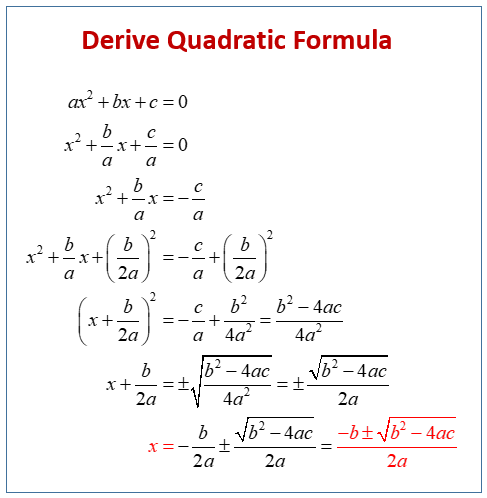Deriving the Quadratic Formula
Related Topics:
Lesson Plans and Worksheets for Algebra I
Lesson Plans and Worksheets for all Grades
More Lessons for Algebra I
Common Core For Algebra I
Examples, solutions, and videos to help Algebra I students learn how to derive the quadratic formula by completing the square for a general quadratic equation in standard form, ax2 + bx + c = 0 , and use it to verify the solutions for equations from the previous lesson for which they have already factored or completed the square.
New York State Common Core Math Algebra I, Module 4, Lesson 14
Common Core Worksheets for Algebra 1
Quadratic Formula Worksheets
Practice using the quadratic formula in the following worksheets.
Quadratic Formula Worksheets
Lesson 14 Summary
The quadratic formula is derived by completing the square on the general form of a quadratic equation ax2 + bx + c = 0, where a ≠ 0.
The formula can be used to solve any quadratic equation and is especially useful for those that are not easily solved by using any other method (i.e., by factoring or completing the square).
The following diagram shows how to derive the Quadratic Formula. Scroll down the page for more examples and solutions on how to use the quadratic formula to solve equations.

This formula gives you the solutions (roots) of any quadratic equation in the form ax² + bx + c = 0.
Lesson 14 Problem Set Sample Solutions
Use the quadratic formula to solve each equation.
- Solve for z. z2 - 3z - 8 = 0
- Solve for q. q2 -8 = 3q
- Solve for m. 1/3 m2 + 2m + 8 = 5
The term b2 − 4ac is called the discriminant.
If b2 − 4ac > 0, there are two real solutions.
If b2 − 4ac &eq; 0, there is one real solution.
If b2 − 4ac < 0, there are no real solutions (the solutions are complex).
Try the free Mathway calculator and
problem solver below to practice various math topics. Try the given examples, or type in your own
problem and check your answer with the step-by-step explanations.

We welcome your feedback, comments and questions about this site or page. Please submit your feedback or enquiries via our Feedback page.